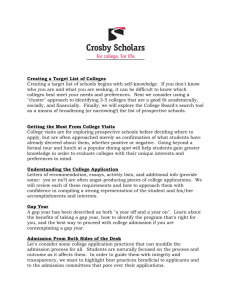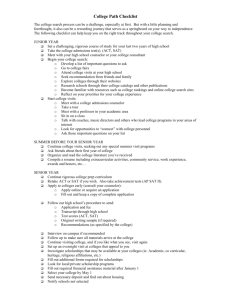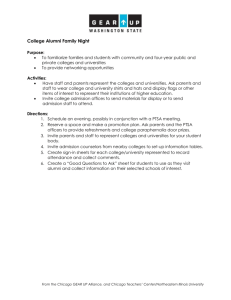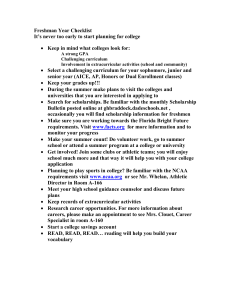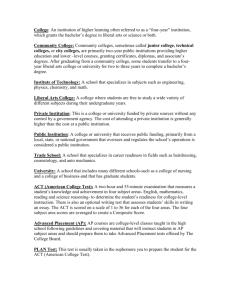College Vocabulary List
advertisement
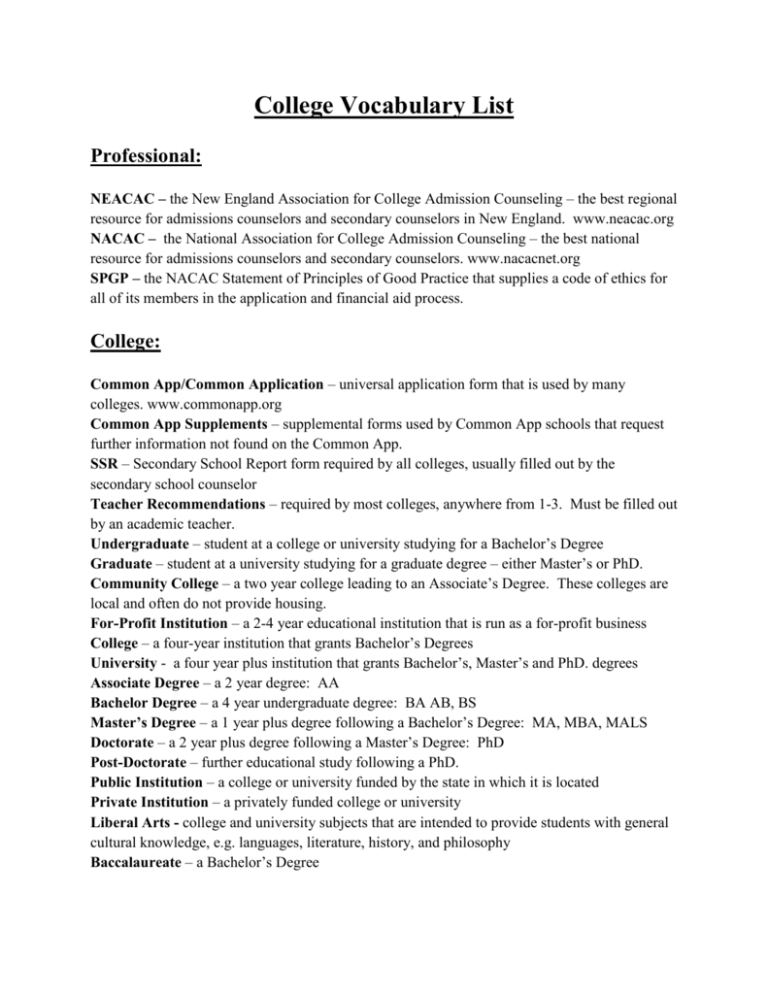
College Vocabulary List Professional: NEACAC – the New England Association for College Admission Counseling – the best regional resource for admissions counselors and secondary counselors in New England. www.neacac.org NACAC – the National Association for College Admission Counseling – the best national resource for admissions counselors and secondary counselors. www.nacacnet.org SPGP – the NACAC Statement of Principles of Good Practice that supplies a code of ethics for all of its members in the application and financial aid process. College: Common App/Common Application – universal application form that is used by many colleges. www.commonapp.org Common App Supplements – supplemental forms used by Common App schools that request further information not found on the Common App. SSR – Secondary School Report form required by all colleges, usually filled out by the secondary school counselor Teacher Recommendations – required by most colleges, anywhere from 1-3. Must be filled out by an academic teacher. Undergraduate – student at a college or university studying for a Bachelor’s Degree Graduate – student at a university studying for a graduate degree – either Master’s or PhD. Community College – a two year college leading to an Associate’s Degree. These colleges are local and often do not provide housing. For-Profit Institution – a 2-4 year educational institution that is run as a for-profit business College – a four-year institution that grants Bachelor’s Degrees University - a four year plus institution that grants Bachelor’s, Master’s and PhD. degrees Associate Degree – a 2 year degree: AA Bachelor Degree – a 4 year undergraduate degree: BA AB, BS Master’s Degree – a 1 year plus degree following a Bachelor’s Degree: MA, MBA, MALS Doctorate – a 2 year plus degree following a Master’s Degree: PhD Post-Doctorate – further educational study following a PhD. Public Institution – a college or university funded by the state in which it is located Private Institution – a privately funded college or university Liberal Arts - college and university subjects that are intended to provide students with general cultural knowledge, e.g. languages, literature, history, and philosophy Baccalaureate – a Bachelor’s Degree Pre-professional – a program of student that leads to a professional degree e.g. nursing, engineering, criminal justice Greek Life – a college or university social network consisting of fraternities and/or sororities Fraternity - a social society for men who are students at a college or university, with a name consisting of individually pronounced Greek letters. Sorority - a social society for women who are students at a college or university, with a name consisting of individually pronounced Greek letters. Resume – a formal list consisting of educational background, accomplishments, employment and other relevant details, used for job-searching and college/summer programs Athletic Resume - a formal list consisting of educational background, athletic accomplishments, and other relevant details, used for college coaches Arts Resume - a formal list consisting of educational background, artistic accomplishments, and other relevant details, used for college/summer arts programs Reach – a school that is a very selective choice for the student, where a student has a less than 50% chance of acceptance, based on GPA/testing and other relevant factors Fifty/Fifty - a school that is a selective choice for the student, where a student has a 50% chance of acceptance, based on GPA/testing and other relevant factors Likely/Probable/Safety - a school that is a reasonable choice for the student, where a student has a more than 50% chance of acceptance, based on GPA/testing and other relevant factors ED/Early Decision – an early application program that demands a binding decision whereby if a student is accepted ED, s/he must attend that school. If a student requires financial aid, the student must attend the school, if the school meets his/her need. A student can only apply to ONE school under the ED program. An ED statement is required with the application, signed by the student, his/her parents and the secondary school counselor. EA/Early Action – a non-binding early application program that will let students know early whether or not they are accepted, denied or deferred. Students may sumit as many EA applications as they wish. Students have until May 1st to decide. REA/Restrictive Early Action - a restrictive early application program that will let students know early whether or not they are accepted, denied or deferred. Students who apply REA may only apply to ONE college under their EA program. Students have until May 1st to decide. Rolling – an application program whereby applications are reviewed and decided as they are received. Priority/VIP Application – a special application particular to an institution sent to targeted applicants Regular Decision – the general admission program for college applications Deferred – students who are deferred under an early application program have their decisions deferred until the regular pool of applicants. Waitlist – students who are not accepted but who are viable candidates for admission can be placed on the waitlist. If a spot should open up after May 1st, that student may be admitted from the waitlist. Most schools keep some financial aid for waitlist candidates. May 1st – the universal deadline for depositing at ONE school for the fall. Double Depositing – the practice of depositing at more than one school, highly frowned upon by colleges and universities and can lead to the rescinding of admissions decisions. Legacy – a student applying to a particular institution where immediate family members have/are attending Information Session – the general information session in the Admissions Office that is part of a college visit. Tour - the tour of the campus, usually by a student tour guide, that is part of a college visit. Testing: College Board – administers PSAT/SAT/SAT Subject Tests/AP Exams. Also offers the PROFILE for financial aid applications. American College Testing Program/ACT – administers the ACT/PLAN PSAT – the Preliminary SAT/National merit Scholarship Qualifying Test usually given to juniors in the fall of the junior year. It tests critical reading, math and writing skills PLAN – a pre-ACT test for sophomores. ACT – ACT’s college admission exam that tests English, math, reading and science. Colleges that require testing accept either the SAT or ACT. SAT – the College Board’s college admission exam that tests critical reading, math and writing skills. Colleges that require testing accept either the SAT or ACT. SAT Subject Test – the College Board’s college admission exam that tests knowledge of individual subjects such as US History or Spanish. Two or more of these tests are usually required by highly selective colleges in combination with the SAT. AP – Advanced Placement Program. AP courses are college courses that are offered by high schools and culminate in an exam offered by the College Board. High grades on the exams can result in college credit. IB – International Baccalaureate. A high quality international education program adopted by many schools as an alternative to AP programs. Score Choice – a score-reporting program for reporting College Board scores that allow students to choose which scores to send to colleges. ETS – Educational Testing Service that administers the TOEFL test. TOEFL – Test of English as a Foreign Language, required for all students applying to college for whom English is not their first language. The iBT – internet based test – is the test most generally accepted. Financial Aid FAFSA – the Free Application for Federal Student Aid. Must be filled out by students and parents seeking financial aid each year. PIN number – a 4-digit number used to access and sign your FAFSA. PROFILE - an additional financial aid form required by some schools, administered by the College Board. Must be filled out by students and parents; a fee is required. EFC – Estimated Family Contribution – the amount that a family is expected to pay for college, calculated as a result of filling out the FAFSA and used by colleges to figure out financial aid. PLUS loan – a federal loan program for parents of undergraduate students to use to fund college. Pell Grant – The Federal Pell Grant Program provides need-based grants to low-income undergraduate and certain post-baccalaureate students to promote access to postsecondary education. Students may use their grants at any one of approximately 5,400 participating postsecondary institutions. Grant amounts are dependent on: the student's expected family contribution (EFC) (see below); the cost of attendance (as determined by the institution); the student's enrollment status (full-time or part-time); and whether the student attends for a full academic year or less. Pell grants do not have to be repaid. Stafford Loan – these are fixed-rate student loans for undergraduate and graduate students attending college at least half-time. Stafford loans are the most common and one of the lowestcost ways to pay for school. Perkins Loan - The Federal Perkins Loan Program provides low-interest loans to help needy students finance the costs of postsecondary education. Students can receive Perkins loans at any one of approximately 1,800 participating postsecondary institutions. Institutional financial aid administrators at participating institutions have substantial flexibility in determining the amount of Perkins loans to award to students who are enrolled or accepted for enrollment. Borrowers who undertake certain public, military, or teaching service employment are eligible to have all or part of their loans canceled. Work Study - The FWS Program provides funds that are earned through part-time employment to assist students in financing the costs of postsecondary education. Students can receive FWS funds at approximately 3,400 participating postsecondary institutions. Institutional financial aid administrators at participating institutions have substantial flexibility in determining the amount of FWS awards to provide to students who are enrolled or accepted for enrollment. Hourly wages must not be less than the federal minimum wage. Gapping – the “gap” between what a college awards in financial aid and the cost of attending the college. Certification of Finances – a financial form available from each college, accompanied by a bank statement, that is required for all international students applying to US institutions. Athletics NCAA – The National Collegiate Athletic Association; administers 23 college sports and championships for those supports. Enforces NCAA rules and oversees scholarships. NCAA Eligibility Standards – NCAA academic standards re. core courses, grades and test scores for athletes needed in order to qualify for Divisions I, II, and III. Division I – offers at least 7 sports for men and women or 6 for men and 8 for women. Offers financial aid awards to student athletes. Division II - offers at least 5 sports for men and women or 4 for men and 6 for women. Offers financial aid awards to student athletes. Division III - offers at least 5 sports for men and women. No financial aid awards to student athletes. Core Courses – Courses that your high school offers that have been approved as NCAA Core Courses and are therefore used for eligibility determinations.
